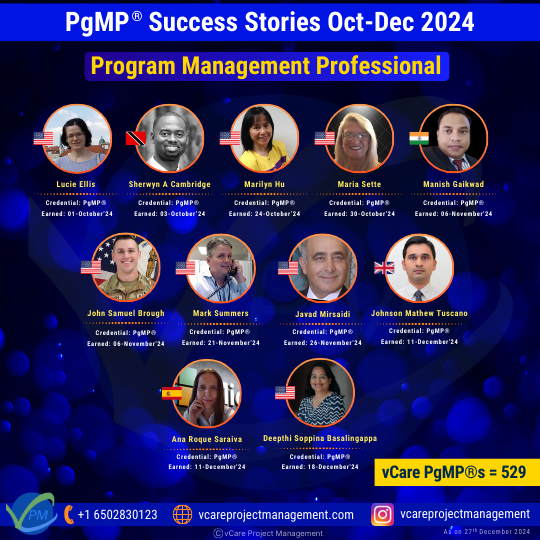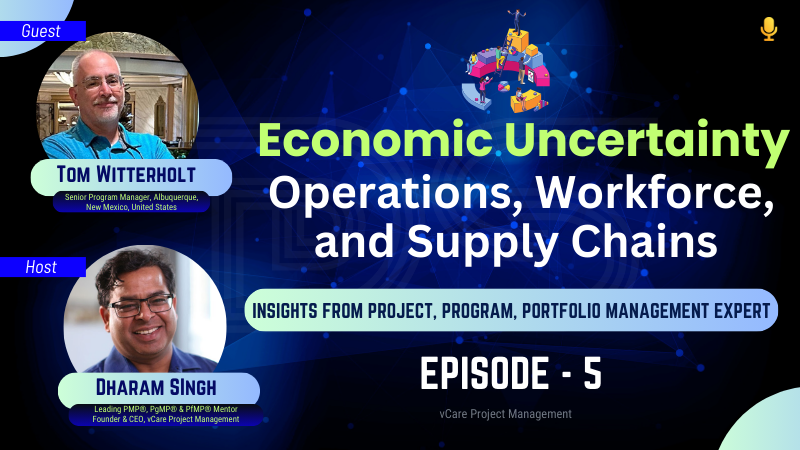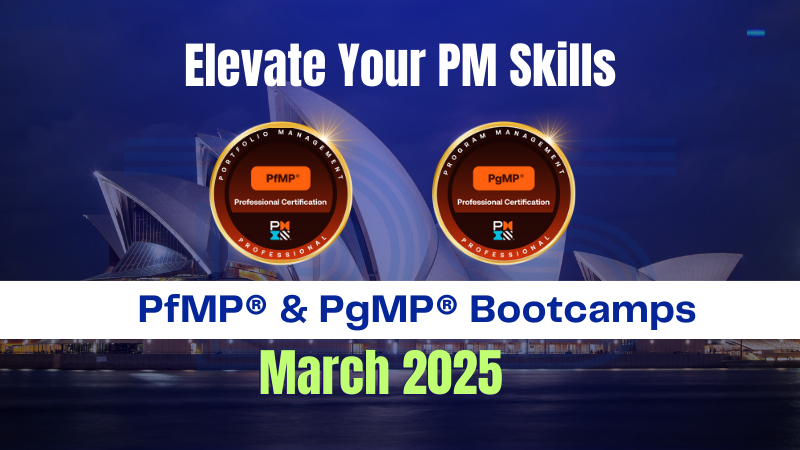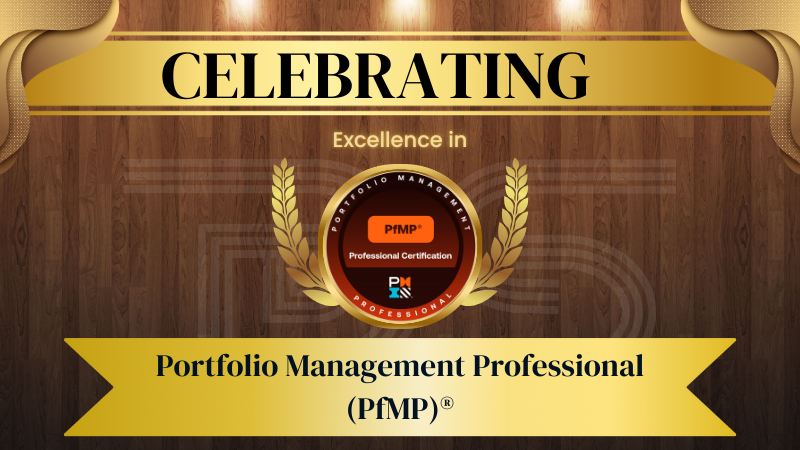
by DharamCW | Jan 8, 2025 | Professional Development Webinars
Innovative Project Management Practices | Olajumoke Akinwunmi | vCare PMP Success Story
Join me for an exclusive webinar featuring the renowned Olajumoke Akinwunmi, a real estate and investment management trailblazer based in Lagos, Nigeria, with over two decades of transformative leadership experience. This session is designed to inspire and educate professionals in project, program, and portfolio management.
Key topics include:
1. The Value of Continuous Professional Development: Insights from Pursuing PMP® Certification
2. Transformative Practices in Real Estate and Investment Project Management
3. Harnessing Technology for Enhanced Project Management Efficiency and Complexity Handling
4. Integrating Sustainability with Project Management: Lessons from an EDGE Expert
5. Strategies for Building High-Performing, Inclusive Teams in Complex Projects
6. Anticipating Future Disruptions and Preparing for the Next Era of Project Management
Don’t miss this opportunity to learn from Olajumoke’s inspiring journey, earn 1 PDU, and enhance your professional toolkit. As a bonus, attendees will receive an exclusive discount code for vCare’s upcoming certification programs.
🔗 Reserve your spot now: https://bit.ly/3ZxZOx4
Session Date: Thursday, 23rd January 2025
Session Time: 08:00 AM – 09:00 AM (PST) / 09:00 AM – 10:00 AM (MST) / 10:00 AM – 11:00 AM (CST) / 11:00 AM – 12:00 PM (EST) / 01:00 PM – 02:00 PM (BRT) / 04:00 PM – 05:00 PM (GMT) / 05:00 PM – 06:00 PM (WAT/CET) / 07:00 PM – 08:00 PM (AST) / 08:00 PM – 09:00 PM (GST) / 09:30 PM – 10:30 PM (IST)
Promo Video Link: https://youtu.be/Q0YA5RmMXFk
🚀 Elevate Your Project Management Career:
– Book an obligation-free consultation session on Project Management Career, training, and certifications: http://talktodharam.com
– Discover training offers and certification discounts: https://bit.ly/3jWVepD
– Stay updated with our Q&A series and certification success stories by subscribing to the vCare Project Management YouTube channel at https://bit.ly/2YF0wJl
– Follow my podcasts and interviews with Project Management Experts on YouTube at https://bit.ly/2NDY8wd
#PMP #PMPWebinar #ProjectManagement #PMPExam #PMPCourse #PMPTraining #PMPPrep #PMPStudy #RealEstateManagement #InvestmentManagement #LeadershipInProjects #ProfessionalDevelopment #TechnologyInProjects #SustainabilityInPM #EDGEExpert #HighPerformingTeams #InclusiveLeadership #FutureOfProjectManagement #DisruptiveInnovation #AskDharam #DharamSingh #DharamSinghPgMP #DharamSinghPfMP #DharamSinghPMP #vCareProjectManagement

by DharamCW | Jan 4, 2025 | PMI Certification Success Stories
🎉 Celebrating Success: vCare Project Management PgMP Achievements (Oct-Dec 2024) 🌟
Congratulations to all the professionals who achieved their PgMP® certification from October to December 2024 with the support of vCare Project Management training and services! We are proud to share that we have been an integral part of the success stories of 529 professionals from 59 countries to their PgMP® certification since our inception.

vCare PgMP Certification Achievements | Oct-Dec 2024 Success Stories | Dharam Singh & vCare Project Management
This accomplishment highlights the effectiveness of our dedicated training and support services, and we couldn’t be more thrilled to have played a role in your journey. We are eager to continue supporting your professional growth and helping you achieve even greater milestones in the future.
Are you ready to take the next step in your career and elevate your program management skills? Whether you’re just starting your PgMP journey or looking to refine your skills, we’re here to guide you. DM me for personalized advice and guidance on your PgMP certification journey. Let’s make the next chapter of your professional growth a success!
View our upcoming PgMP Programs
Online – http://bit.ly/2oBKQXQ
Direct – http://bit.ly/2oCfpg0
Join our PgMP4U LinkedIn Group for the latest updates – http://bit.ly/2SBPwIp
Explore our useful PgMP Study Materials:
Complete Reference Guide for PgMP Certification | 6th Edition – https://bit.ly/3gsEkKj
PgMP Pathfinder | PgMP Mind Maps based Examination Content Outline – https://bit.ly/3pLkazn
The Standard for Program Management | Fifth Edition – https://bit.ly/43lqq4I
PgMP Challenger Gold (Mock Exams 1 to 5) | Exam Simulator – https://bit.ly/3NGrysU
PgMP Challenger Silver (Mock Exams 1 to 3) | Exam Simulator – https://bit.ly/44rOIKY
PgMP Challenger Mock Exam 1 | Exam Simulator – https://bit.ly/2RMmMAk
PgMP Challenger Mock Exam 2 | Exam Simulator – https://bit.ly/3Urs7JA
PgMP Challenger Mock Exam 3 | Exam Simulator – https://bit.ly/3JM9afX
For more insights into program management certification, training, and career development, book a personalized, obligation-free consultation session using http://talktodharam.com
Looking to deepen your knowledge? Check out our upcoming webinars featuring global experts,
1. Mastering Program Quality featuring Panagiotis Gemenetzis – https://bit.ly/3OiQAy5
2. Innovative Project Management Practices featuring Olajumoke Akinwunmi – https://bit.ly/3ZxZOx4
3. PMO Digital Transformation Leadership: Insights and Success featuring Sherwyn Cambridge PgMP®, PMP®, MBA® – https://bit.ly/4iMvyWE
4. Culture, People, Programs, Risks: Leadership Redefined featuring Lucie Ellis, SHRM-SCP, PgMP, RMP, Prosci, PMP, A-CSM, MS – https://bit.ly/3VXv4mW
#PgMP #ProgramManagement #PgMPCertification #vCarePgMP #PgMPSuccess #UnitedStates #USA #Canada #Spain #UnitedKingdom #TrinidadAndTobago #India #PMIPgMP #PgMPExam #PgMPCourse #PgMPTraining #PgMPPreparation #PgMPGuide #PgMPPrep #PgMPOnlineTraining #PgMPBootcamp #AskDharam #DharamSingh #DharamSinghPgMP #vCareProjectManagement

by DharamCW | Jan 3, 2025 | Industry Trends and Insights
Economic Uncertainty: Operations, Workforce, and Supply Chains | Tom Witterholt | PMI PgMP | Episode 5
Why do organizational leaders need to worry about economic uncertainty directly affecting the operations, workforce gap, and supply chain drivers?
– Impact of Economic Uncertainty
– Workforce Challenges
– Attrition rate – Hire or Fire
– Amazing Success or Amazing Failure
🚀 Looking to deepen your knowledge? Check out our upcoming webinars featuring global experts,
1. Mastering Program Quality: Insights from a PgMP-Certified Expert featuring Panagiotis Gemenetzis – https://bit.ly/3OiQAy5
2. Innovative Project Management Practices featuring Olajumoke Akinwunmi – https://bit.ly/3ZxZOx4
3. PMO Digital Transformation Leadership: Insights and Success featuring Sherwyn Cambridge – https://bit.ly/4iMvyWE
4. Culture, People, Programs, Risks: Leadership Redefined featuring Lucie Ellis – https://bit.ly/3VXv4mW
– Book an obligation-free consultation session on Project management Career, training, and certifications: http://talktodharam.com
– Discover training offers and certification discounts: https://bit.ly/3jWVepD
– Stay updated with our Q&A series and certification success stories by subscribing to the vCare Project Management YouTube channel at https://bit.ly/2YF0wJl
– Follow my podcasts and interviews with Project Management Experts on YouTube at https://bit.ly/2NDY8wd
#PgMP #PfMP #PMP #PMI #EconomicUncertainty #WorkforceChallenges #SupplyChainResilience #OperationalExcellence #TalentManagement #AttritionRate #EmployeeRetention #BusinessContinuity #HiringTrends #FutureOfWork #LeadershipInCrisis #EconomicImpact #SupplyChainDisruption #DigitalTransformation #OperationalEfficiency #WorkforceStrategy #BusinessSurvival #AskDharam #TomWitterholt #DharamSingh #DharamSinghPgMP #DharamSinghPfMP #DharamSinghPMP #vCareProjectManagement

by DharamCW | Dec 29, 2024 | vCare PMI Certification Training Classes
🌟 Exciting News for Project, Program, and Portfolio Managers in Australia! 🌏
Join me this February and March 2025 for exclusive PfMP and PgMP certification boot camps in Melbourne and Sydney. Let’s transform your career!
🎯 Why Attend?
+ Tailored training to boost your Program and Portfolio management skills.
+ Expert guidance for certification success.
+ Focused & Collaborative Learning
+ Real-Time Interaction
+ Networking with like-minded professionals.
📍 Where & When?
In Melbourne,
PgMP Physical Bootcamp, February 21 – 23, 2025 – https://bit.ly/3XZ1KwD
PfMP Physical Bootcamp, February 24 – 26, 2025 – https://bit.ly/3UpVqxh
In Sydney,
PgMP Physical Bootcamp, February 14 – 16, 2025 – https://bit.ly/3zSdGbq
PfMP Physical Bootcamp, March 7 – 9, 2025 – https://bit.ly/4dLj2Dh

Exclusive PfMP and PgMP bootcamps in Melbourne and Sydney this February and March 2025 with expert training from vCare Project Management
For any questions related to your Project Management career, training, and certifications, you can book an obligation free 15 minutes session with me by visiting talktodharam.com
Subscribe to vCare Project Management YouTube Channel to catch future videos of our Q&A series and certification success stories: https://bit.ly/2YF0wJl
Subscribe and follow Dharam Singh Podcasts and interviews with Project Management Experts on YouTube at https://bit.ly/2NDY8wd
Check the various other offers and discounts we offer on our programs at https://bit.ly/3jWVepD
#PfMP #PgMP #ProjectManagement #Bootcamp #Melbourne #Sydney #Australia #CertificationSuccess #vCareProjectManagement #PgMPBootcamp #PfMPBootcamp #PgMPCertification #PMIPgMP #PgMPExam #PgMPCourse #PgMPTraining #PMPPgMP #PgMPPreparation #PgMPGuide #PgMPPrep #PfMPCertification #PMIPfMP #PfMPCourse #PfMPExam #PfMPPMI #PfMPTraining #AskDharam #DharamSingh #DharamSinghPgMP #DharamSinghPfMP #vCareProjectManagement

by DharamCW | Dec 28, 2024 | PMI Certification Success Stories, Portfolio Management
🎉 Celebrating Success: vCare PfMP Achievements (Sept-Dec 2024) 🌟
Congratulations to all the professionals who achieved their PfMP® certification from September to December 2024 with the support of vCare Project Management training and services!
We are excited to share that our PMI community has grown to over 2,090+ PfMP® certified professionals worldwide, and vCare Project Management is proud to have been an integral part of the success stories of 155 new PfMP®s across 31 countries globally.

Congratulations to the 155 professionals who achieved PfMP certification with vCare Project Management from September to December 2024
This accomplishment highlights the effectiveness of vCare Project Management‘s dedicated training and support services, and we couldn’t be more thrilled to have played a role in your journey. We are eager to continue supporting your professional growth, helping you achieve even greater milestones in the future.
Are you ready to take the next step in your career and elevate your portfolio management skills? Whether you’re just starting your PfMP journey or looking to refine your skills, we’re here to guide you. DM me for personalized advice and guidance on your PfMP certification journey. Let’s make the next chapter of your professional growth a success!
View our upcoming PfMP Programs
Online – http://bit.ly/39jOZSf
Direct – http://bit.ly/38er2M3
Join our PfMP4U LinkedIn Group for the latest updates – http://bit.ly/31P7GKR
Explore our useful PfMP Study Materials:
PfMP Pathfinder – https://bit.ly/35j9Dli
The Complete Reference Guide for PfMP Certification – https://bit.ly/3pU4ud5
PfMP Challenger Mock Exam 1 | Exam Simulator – https://bit.ly/3KKZkv3
PfMP Challenger Mock Exam 2 | Exam Simulator – https://bit.ly/3VlI5FH
PfMP Challenger Mock Exam 3 | Exam Simulator – https://bit.ly/3VNrfRL
PfMP Challenger Gold (Mock Exams 1 to 3) | Exam Simulator – https://bit.ly/3KCjbNh
For more insights into portfolio management certification, training, and career development, book a personalized, obligation-free consultation session with me at http://talktodharam.com
Looking to deepen your knowledge? Check out our upcoming webinars featuring global experts,
1. Mastering Program Quality: Insights from a PgMP & PfMP Certified Expert featuring Panagiotis Gemenetzis – https://bit.ly/3OiQAy5
2. Innovative Project Management Practices featuring Olajumoke Akinwunmi – https://bit.ly/3ZxZOx4
3. PMO Digital Transformation Leadership: Insights and Success with Sherwyn Cambridge PgMP®, PMP®, MBA® – https://bit.ly/4iMvyWE
#PfMP #PortfolioManagement #PMIPfMP #vCarePfMP #PfMPSuccess #SuccessStory #Congratulations #PfMPCertification #TrinidadAndTobago #Greece #Canada #Germany #USA #UnitedStates #Qatar #Brazil #PfMPCourse #PfMPHandbook #PfMPBook #PfMPRequirements #PfMPExam #PfMPPMI #PfMPTraining #PMICertification #PortfolioManager #AskDharam #DharamSingh #DharamSinghPfMP #vCareProjectManagement #PortfolioManagementCertification #PortfolioManagementInstitute #PortfolioManagementCourse











Recent Comments